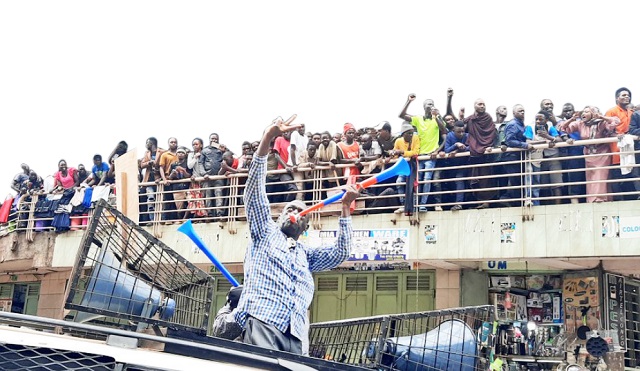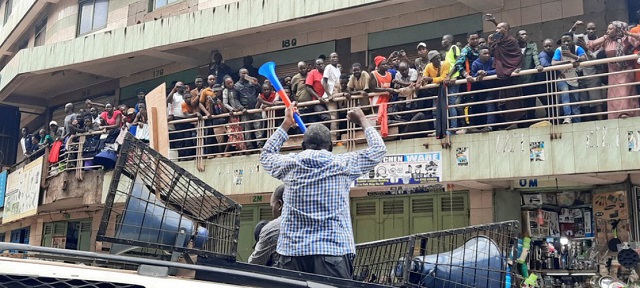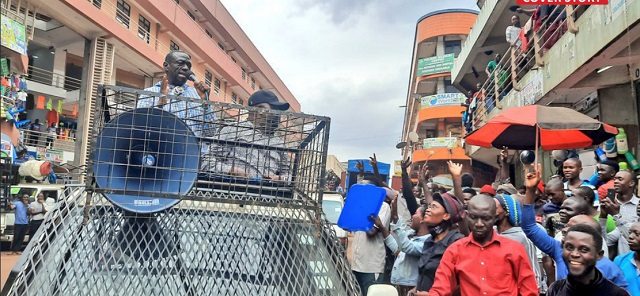
BESIGYE PROTESTS: Will they ever achieve change?
Kampala, Uganda | IAN KATUSIIME | Rtd Col. Dr. Kizza Besigye knows when and where to strike. With prices of most consumer goods rising rapidly and hitting the urban poor hardest, and the government appearing to have no convincing explanations or solutions, the de facto leader of political opposition to President Yoweri Museveni decided to attack.
Clad in his blue checked jumper synonymous with his protests against Museveni’s government, the four time presidential candidate jumped into his protest vehicle, a large Toyota SUV rigged with loud-hailers, and hit the road in the Kampala city centre to rally protests.
In a cat and mouse game that ran for days, he eluded and battled police, was cheered by crowds in the Central Business District, and was eventually detained. He had on May 24 spent the afternoon in the heart of Kampala’s business community in Kikuubo mounted atop his vehicle. Crowds in Kampala’s downtown business arcades cheered Besigye as he delivered his clarion call for action on an irresponsive government.
Then police pounced on him and whisked him off to Nagalama Police station in Mukono district, a preferred detention centre by the police for the veteran politician.
Even as he was being led away, speaking in Luganda, Besigye roared, “These police officers are badly off. They sleep in bad conditions and their kids go hungry.”
Besigye exhorted Ugandans, uninformed and non-uniformed to rise up and liberate the country from those in charge. But nobody joined him.
By the time we went to press, he was still remanded to prison on charges of attempting to incite violence. He was offered bail of a whopping Shs30 million. But he was as defiant as ever. “I would rather endure remand than pay Shs30m cash for bail,” he said.
By the time we went to press, no crowd-funding account had been opened to collect funds for his bail.
Protests by Besigye, often alone, with driver and or aide, often spark two questions: Why does he do it? Can they really achieve anything? Why is the government so afraid of them and why does it determinedly quash them?

Besigye’s clarion call
Besigye’s recent solo protest was a hark back to the days of Walk to Walk, weeks after the 2011 election where the country witnessed a sharp rise in food and fuel prices. The government’s response then was equally brutal but the protests spread among the urban youth who searched for jobs in vain.
A pressure group, Activists For Change (A4C), was created by Mathias Mpuuga, current Leader of Opposition in Parliament, to coordinate the Walk-to-Work protests. Although banned by government using an old colonial law, Besigye had launched a movement of protests in Uganda that is still manifest today.
The main actor however remained Besigye, a wildly popular figure in urban areas with an ability to galvanize crowds and fence sitters into action. At the time, Besigye was on his third election attempt to unseat President Museveni.
For a long time now, Besigye has urged Ugandans to rise up and demonstrate against what he calls a “junta”. According to Museveni’s former physician in the Bush War, elections are a waste of time and no amount of voter mobilisation can generate tangible results.
Since then, Besigye has launched a series of calls for action. In January 2018, he launched Tubalemese (let’s fail them) which was aimed at shunning businesses owned by members of NRM.
In October 2019, Besigye launched Twerwaneko with his ‘People’s Government’ which included Erias Lukwago, Kampala City Lord Mayor and others like ex-Rubaga North MP Moses Kasibante.
Besigye called Twerwaneko a “clarion call” to address the enormity of challenges and injustices the country that is facing; incessant murders, police brutality, kidnaps, poverty. Twerwaneko is premised on Article 3 of the Constitution which puts agency in the hands of Ugandan citizens. The article gives a right to Ugandans to defend the constitution in case anyone tries to overthrow it or abrogate it.
In October 2021, he launched The People’s Front for Transition- a variant of the previous pressure groups with a Red Card symbol.
“This struggle has taken a very long time, a lot of words have been spoken,” Besigye said at the launch of the new group wearing his trademark blue striped hoodie. The Front is made up of splinters from several parties; the Uganda Peoples Congress (UPC), Conservative Party, and JEEMA at whose offices the launch took place. Besigye was flanked by old allies.
According to some political analysts, Besigye has been able to do what his presumed successor, Bobi Wine, has failed to do- lead a sustained movement of protests against Museveni’s government.
Besigye and his supporters who subscribe to defiance through protests pick inspiration from the protests that toppled Sudanese strongman Omar el Bashir who was felled in 2019 as he marked 30 years in power.
The famous Walk-to Work protests also initially got fired up by the Arab Spring protests in Tunisia, Egypt and Libya that broke out after long held economic and political grievances. A decade after, a number of youngsters who took part in the protests are said to have regretted the events having failed to achieve their desired outcome of material gain and improved livelihoods.
Similarly, the protests in Khartoum started in December 2018 after grievances with rising bread prices. A few months later, Bashir was being forced to step down by his own military who joined the side of protestors after Bashir’s stay became untenable.
Harold Kaija, a staunch Besigye supporter and FDC deputy secretary general told The Independent at the time about the seeming invincibility of strong men: “Bashir thought he was going to be on the ballot in 2020. The same with Kabila.” The hope of the Besigye team is clear; that Museveni will fall – one day.
They are hoping for what experts in the psychology of protest and collective action call the “tipping point”.
According to Lauren Duncan, PhD, a professor of psychology at Smith College, a tipping point occurs when “people who have been oppressed or treated unfairly or treated with violence for years and years and years and have been protesting against it for years are joined by the “silent majority” – people who aren’t actually directly affected by this maltreatment finally take an interest and start to get outraged.
“This causes the things to tip over into wide-scale social change,” she said in interview during the Black Lives Matter protests in America.
She gives the example of the many protests that erupted in 2020. She attributes them to the COVID-19 pandemic lockdowns which had people cooped up inside their houses watching vivid images on TV of unjust treatment for months.
Duncan says these are people who before were caught up in daily survival routines, going to work, taking care of their kids, going to school, and basically saying, “I don’t really have time to engage with what’s going on outside of my neighborhood.”
Yet some of those watching had grievances such as job loss, and they started to question.
She said people began to think about what’s really important in life. “That is so unfair they thought. Who am I as a person? I need to take a stand.”
She says internal factors like personality and external factors such as current events, played a part in sparked the year of protest and citizen action, analysts say.
Throughout 2020 numerous hashtags on social media led to protest movements: #EndSARS, #BlackLivesMatter, #ShutItAllDown, #zwartepietisracism, #NotMyPresident, and more.
In Sudan, protest movements brought about direct change in government.

Lone protests
Lone protests are neither new nor unique to Besigye. In one of the best known symbols of defiance, in June 1989 an unknown man, stood, alone, to block a column of army tanks at Tiananmen Square in China during protests.
The incident is iconic because it happened on June 05, 1989, a day after the Chinese violently crashed the student-led protests in which hundreds, if not thousands of protesters were killed.
That massacre of protesters changed China. It led the outlook for its economic future to be downgraded, its acceptance in the World Trade Organisation to be delayed, and because China was a poor country then, bilateral aid was cut and loans suspended by the World Bank.
In similar fashion, in 1955 alone woman, Rosa Parks, refused to sit in the segregated section for Blacks on a bus in Montgomery, Alabama. That action invigorated the civil rights movement and involved activists including Dr. Martin Luther King, Jr. It led to many events that changed the face of race relations in America.
In more recent memory, the famous came of Mohamed Bouazizi comes to mind. Bouazizi was a Tunisian street vendor who set himself on fire on December 17 2010 after municipal authorities confiscated his wares and out of the harassment and humiliation carried out an act of self-immolation. His sole act of protests sparked a revolution that birthed the Arab Spring protests and subsequently changed the Arab world. The protests dominated the news for the next year.
Experts in social psychology, collective behavior, or crowd theory explain why people protest. Many say protesting is an interesting subject to study because it goes against the human tendency to prefer “the safety and security of status quo”.
According to them, history has shown that protests are the result of feelings like fear, frustration, and helplessness.
Oftentimes it only takes one person to be the tipping point for collective action.
Protests happen when people lose trust in the government, their leaders or people in authority. They realise they are being scammed, taken advantage of, or lied to.
“This causes panic and anger,” says Nicole F. Roberts, an expert in behavioral science, “when these strong, negative emotions combine, there is no greater fuel for a fire.”
“There are almost no emotions worse for humans than those of vulnerability and helplessness, those shared feelings can easily boil over, uniting people. And grievances are a very strong motivation for mobilization,” she says. The grievances could be financial, political, sexual, or any shared identity and purpose.
“When emotions run high, people make decisions they wouldn’t under “normal” circumstances,” says Roberts.
Some people like Besigye or fellow former presidential candidate Samuel Lubega Mukaku who has joined him in the latest protest, might want their names and faces associated with the protest. But many others, because of fear of persecution, prosecution, or retaliation, want to act in a group. It enables them to be anonymous, share risk, and disperse responsibility.
Experts say social media and digital technology makes protest much easier. It offers low-cost ways to donate money to causes or just click a like or repost a protest message. It creates efficiency, where one person tweeting felt like a waste of time, energy, or money, suddenly catches fire and there is more attention and resources.
Disruptors matter
When confronted by protests, governments and people in authority often brand them negatively as disruptors, terrorists, and a nuisance.
Yet history shows that protests can lead to positive change like the end of apartheid in South Africa, increased wages and better working conditions, lower prices, the right to vote, and more.
That is why protest should always be seen as a legitimate avenue towards policy change and influence. They must be reflective of what the society wants, needs and demands, according to one writer.
One critical ingredient is that any protester must also be willing to dialogue.
“You must focus on facilitating and strengthening dialogue mechanisms between the government and citizens,” says Hugo Santiago Barrail, “Antagonistic and violent strategies often prove counter-productive in bringing about sustainable and concrete change.” He says protesters need to reach out both to those in power and unconvinced citizens through peaceful methods if available.
“For a protest to be powerful, you must communicate clearly about why you are protesting and what changes you desire,” says Salome Nthenya Nzuki.
One of Besigye’s placards was inscribed on `Transition Now Not Succession’. Another read: “Time Up! Out.” Yet the protest was against the rising prices.
She gives the case of the #MyDressMyChoice protests in Kenya in 2014. These happened when a woman was publicly stripped by men at a bus station and groped for wearing a mini skirt. Thousands of Kenyan women were angered by the act and the constant abuse of women while in transit. The incidence gave birth to the #MyDressMyChoice protests where Kenyan women took to the streets to demand the elimination of all forms of violence against women and, in particular, calling for prosecution of the men who stripped the woman and for this to be explicitly be made illegal.
The protests caught the attention of women’s rights organizations, the judiciary, the deputy president and the president himself. The men were arrested and prosecuted and it is now illegal in Kenya to strip a woman.
Protests must also aim to attract a broad coalition of different people. This involves mobilising a wide range of voices and not just listening to members of the main protesters camp.
Sometimes this means engaging with equally aggrieved activists in other countries who are also striving for the same change.
“It is crucial to link up with organisations in your own country which are working towards similar goals, but do not underestimate the value of connecting to other social activists as well,” says Zakaria Ouadah. Those are views that Besigye possibly needs to work on.
****
 The Independent Uganda: You get the Truth we Pay the Price
The Independent Uganda: You get the Truth we Pay the Price



This is such an interesting piece. I however find Ugandan analysts taking a wrong (or irrelevant) angle when it comes to this particular matter. I have never understood this as Dr. Besigye fighting a personal war against President Museveni as most people have chosen to believe. And even if it were the case, we all clearly see objective surroundings that would have pushed the rest of us to the streets.
Secondly, I disagree with the author saying Dr. Besigye knows “the right time to do this”. In my view, it entirely arises out of need. In this particular case, there is need for prices to be stabilized. There’s need to address the inflation problems. People’s nominal incomes have been greatly affected.
As a country, as Socrates stated, we have a social contract that binds us – implicit or explicit. Therefore for us as a people to live in accordance with the social contract, there must inevitably be implicit or explicit reactions to any sort of perceived abrogation by the state. The question of whether the ongoing protests will achieve change has got no definite answer.
Subversive activities are not for leisure or fun; they are an eruption that arises form from discomfort, dissatisfaction or perceived mistreatment. They therefore can’t be crushed forever. They however have gradual stages: (1) incubation stage, (2) moderate stage and (3) crisis stage. The most critical stage here is the crisis stage. This is when violence increases, and radicals gain control. In this stage, radicals start to create illegitimate assemblies and dispense harsh justice.
I believe we are almost here. At this stage, people can no longer afford basics like food, transport, accommodation and so forth. It’s a stage of starvation, unemployment, illiteracy, death and all sorts of sufferings. It’s a stage in which the natives give up on life and are ready to follow whoever is available mobilize them. In this stage, it is beyond political parties or politicians. It’s about one fighting for oneself.
In short, this is a natural gradual process. Its success entirely depends on the state’s reaction to people’s grievances.